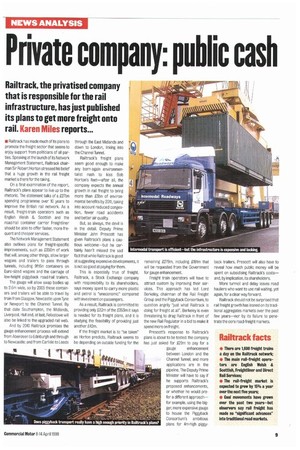Private company: public cash
Page 11

If you've noticed an error in this article please click here to report it so we can fix it.
Railtrack, the privatised company that is responsible for the rail infrastructure, has just published its plans to get more freight onto rail. Karen Miles reports...
• Railtrack has made much of its plans to promote the freight sector that seems to enjoy support from politicians of all parties. Speaking at the launch of its Network Management Statement, Railtrack chairman Sir Robert Horton stressed his belief that a huge growth in the rail freight market is there for the taking.
On a first examination of the report, Railtrack's plans appear to live up to the rhetoric. The statement talks of a £27bn spending programme over 10 years to improve the British rail network. As a result, freight-train operators such as English Welsh & Scottish and the road/rail container carrier Freightliner should be able to offer faster, more frequent and cheaper services.
The Network Management Statement also outlines plans for freight-specific improvements, such as .2,350m of work that will, among other things, allow larger wagons and trailers to pass through tunnels, including 9ft6in containers on Euro-sized wagons and the carriage of low-height piggyback road/rail trailers.
The gauge will allow swap bodies up to 2.6m wide, so by 2005 these containers and trailers will be able to travel by train from Glasgow, Newcastle upon Tyne or Newport to the Channel Tunnel. By that date Southampton, the Midlands, Liverpool, Hull and, at last, Felixstowe will also be linked to the upgraded rail web, And by 2010 Railtrack promises the gauge enhancement process will extend from Aberdeen to Edinburgh and through to Newcastle: and from Carlisle to Leeds through the East Midlands and down to London, inking into the Channel Tunnel.
Railtrack's freight plans seem good enough to make any born-again environmentalist rush to kiss Bob Horton's feet—after all, the company expects the annual growth in rail freight to bring more than £3bn of environmental benefits by 2011, taking into account reduced congestion, fewer road accidents and better air quality.
But, as always, the devil is in the detail. Deputy Prime Minister John Prescott has given Railtrack's plans a cautious welcome—but he certainly hasn't missed the sad fact that while Railtrack is good at suggesting expensive developments, it is not so good at paying for them.
This is especially true of freight. Railtrack, a Stock Exchange company with responsibility to its shareholders, says money spent to carry more plastic and petrol is "uneconomic compared with investment on passengers.
As a result, Railtrack is committed to providing only £32m of the £353m it says is needed for its freight plans, and it is studying the feasibility of providing just another 242m.
If the freight market is to be taken" as Horton predicts, Railtrack seems to be depending on outside funding for the remaining £279m, including £191m that will be requested from the Government for gauge enhancement Freight train operators will have to attract custom by improving their services. This approach has led Lord Berkeley, chairman of the Rail Freight Group and the Piggyback Consortium, to question angrily "just what Railtrack is doing for freight at air. Berkeley is even threatening to drag Railtrack in front of the new Rail Regulator in a bid to make it spend more on freight.
Prescott's response to Railtrack's plans is about to be tested: the company has just asked for 129m to pay for a
gauge enhancement between London and the Channel Tunnel, and more applications are in the pipeline. The Deputy Prime Minister will have to say if he supports Railtrack's proposed enhancements, or whether he would prefer a different approach— for example, using the bigger, more expensive gauge to house the Piggyback Consortium's ambitious plans for 4m-high piggy
back trailers. Prescott will also have to reveal how much public money will be spent on subsidising Railtrack's costs— and, by implication, its shareholders.
More turmoil and delay leaves road hauliers who want to use rail waiting, yet again, fora clear way forward.
Railtrack should not be surprised that rail freight growth has leaned on its traditional aggregates markets over the past few years—nor by its failure to penetrate the core road-freight markets.




































































































